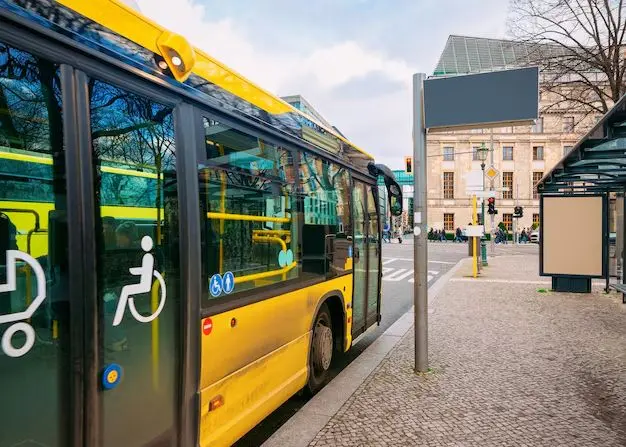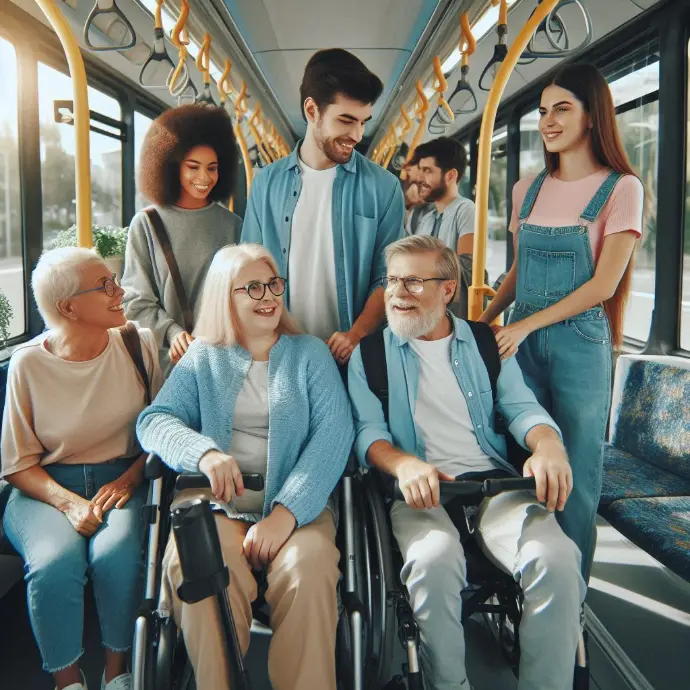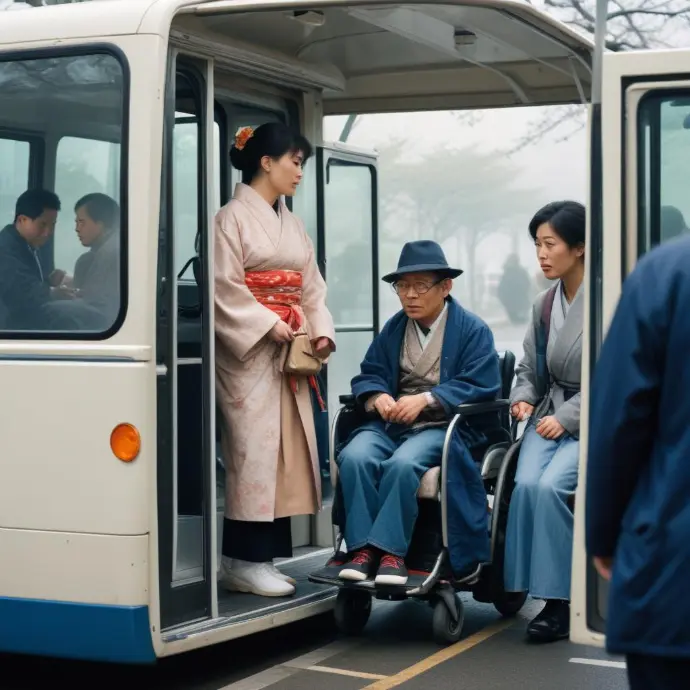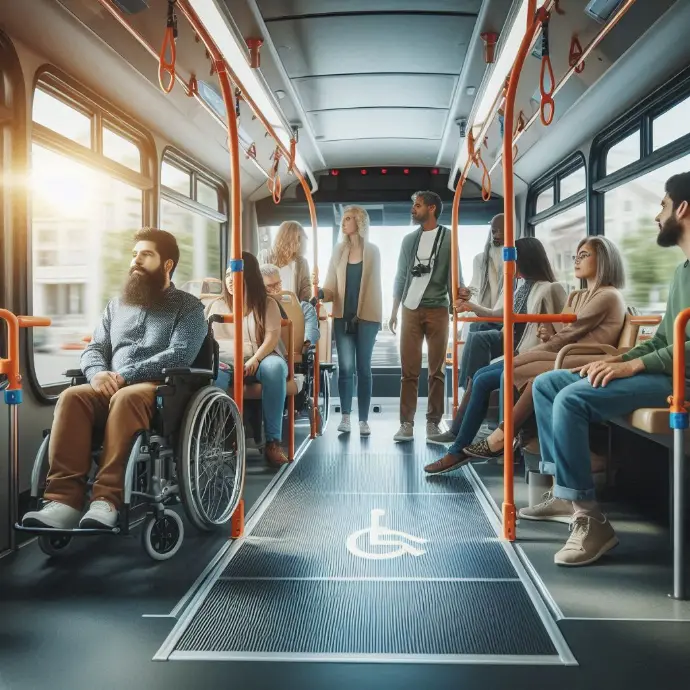
Transport for all: Advances and challenges
in mobility for people with disabilities

Here you will find a space dedicated to the in-depth exploration
of human rights around the world. In our main article
"Transport for All: Advances and Challenges in the Mobility of People with Disabilities"
we will analyze the advances in accessible transportation for the disabled.
Find out how barriers and challenges are being overcome in the mobility of people with disabilities!
Table of Contents
- Importance of accessible transport for persons with disabilities
- Context of the rights of persons with disabilities at a global level
- Current challenges in the mobility of persons with disabilities
- Advances in accessible transport for the disabled
- Innovations in vehicles adapted for persons with disabilities
- Policies and regulations to guarantee access to transport for persons with disabilities
- Impact of advances on the quality of life of persons with disabilities
- Challenges in the mobility of persons with disabilities
- Architectural and urban barriers in public and private transport
- Economic difficulties in accessing adapted transport
- Lack of awareness and training in the treatment of persons with disabilities in transport
- Legislation and rights in accessible transport
- International regulations on the right to mobility of persons with disabilities
- Legal guarantees for access to adapted transport at a national level
- Social and economic impact of accessible transport
- Employment and education: access facilitated through adapted transport
- Costs and benefits of implementing accessibility measures in the transport
- Significant advances in transport accessibility for people with disabilities
- Pending challenges and areas for improvement in mobility for people with disabilities
- Importance of continuing to promote the right to inclusive and accessible transport
Final reflection: Advances in accessible transport for the disabled
Here you will find a space dedicated to the in-depth exploration of human rights around the world. In our main article "Transport for All: Advances and Challenges in the Mobility of People with Disabilities" we will analyze the advances in accessible transportation for the disabled. Find out how barriers and challenges are being overcome in the mobility of people with disabilities!

Importance of accessible transport for persons with disabilities
Access to adequate transport is essential to ensure mobility and active participation in society for persons with disabilities. An accessible transport system not only facilitates social inclusion, but also promotes equal opportunities and the full exercise of human rights. The availability of transport options adapted to the needs of persons with disabilities is essential for their independence and autonomy.
Access to accessible transport involves not only the availability of adapted vehicles, but also adequate infrastructure, staff training and awareness-raising in society as a whole. Lack of accessible transport can significantly limit participation in education, employment, healthcare and other activities essential to daily life. Therefore, advancing accessible transport for persons with disabilities is crucial to comply with the principles of equality and non-discrimination enshrined in the United Nations Convention on the Rights of Persons with Disabilities.
Context of the rights of persons with disabilities at the global level
The fight for the rights of persons with disabilities has gained ground globally in recent decades. The Convention on the Rights of Persons with Disabilities, adopted by the United Nations General Assembly in 2006, represents a milestone in the recognition and protection of the human rights of persons with disabilities at the international level.
This Convention recognizes that persons with disabilities have the right to equal opportunities and to participate fully in social and cultural life. In addition, it establishes the obligation of States parties to guarantee access to mobility and transportation for persons with disabilities, as part of their commitment to the elimination of barriers that limit their participation in society.
Despite these advances, many persons with disabilities continue to face significant obstacles in accessing adequate transportation. Current challenges in the mobility of persons with disabilities reflect the need to continue working on the effective implementation of the rights recognized in the Convention.

Current challenges in mobility for people with disabilities
Worldwide, people with disabilities face a wide range of mobility challenges. Lack of accessible infrastructure, limited accessible transport options, discrimination in accessing public transport services and lack of awareness of the needs of people with disabilities are just some of the obstacles that limit their mobility.
In addition, lack of training for transport personnel and the absence of clear accessibility regulations contribute to the perpetuation of barriers for people with disabilities. These challenges not only affect the ability of people with disabilities to move around, but also impact their participation in social, economic and civic life. Progress in overcoming these challenges requires a comprehensive approach ranging from accessible urban planning to the promotion of innovative technologies in adapted transport. The active participation of persons with disabilities and their organisations in policy formulation and decision-making related to accessible transport is also essential.
Advances in accessible transportation for the disabled
The implementation of technologies has been instrumental in improving accessibility in transportation for people with disabilities. The development of mobile applications that provide real-time information on the accessibility of transportation modes, such as buses and trains, has greatly facilitated trip planning. These applications provide details on accessible routes, arrival times, and alternative options in case of service disruptions. Likewise, the installation of audio and destination display systems in vehicles has contributed to making public transportation more inclusive for people with visual or hearing impairments. These technological advances represent a significant step towards creating a truly accessible transportation system for all.
In addition, the implementation of assistive technologies in vehicles, such as lifting platforms and wheelchair anchoring systems, has improved the travel experience for people with physical disabilities. These innovations allow users to board and disembark safely and without obstacles, which previously represented a significant challenge. The combination of technology and transportation has paved the way for greater autonomy and mobility for people with disabilities, marking a significant advance in equal access to transportation services.
In this regard, it is crucial that governments and transport companies continue to invest in the implementation of innovative technologies that guarantee universal accessibility in all aspects of public and private transport. These advances not only promote inclusion, but also enrich the quality of life of people with disabilities by giving them the freedom to move independently and safely.

Innovations in Adapted Vehicles for People with Disabilities
In the area of mobility for people with disabilities, innovations in adapted vehicles have revolutionized the way in which people with disabilities can move around. The introduction of vehicles specially designed to meet the needs of people with different types of disabilities has represented a significant advance in access to transport. For example, vehicles equipped with automatic ramps or hydraulic lifting systems have facilitated access for passengers in wheelchairs, removing physical barriers that previously limited their mobility. In addition, the adaptation of vehicles for people with motor disabilities has allowed driving using modified control systems, such as manual controls or voice controls, giving these people the freedom to move independently. In addition, the availability of vehicles with ergonomic features and customized adjustments has improved comfort and safety during travel, ensuring a more inclusive and satisfactory travel experience. It is crucial to highlight that these innovations in adapted vehicles not only benefit people with disabilities, but also contribute to raising awareness in society about the importance of accessibility in transport. By encouraging the development and adoption of adapted vehicles, greater integration of people with disabilities in all aspects of daily life, including travel, is promoted. This inclusive approach is essential to building a more equitable and compassionate society, where all people have the opportunity to participate fully in social and working life.
Policies and regulations to ensure access to transport for people with disabilities
Policies and regulations play a fundamental role in ensuring access to transport for people with disabilities. At a global level, numerous countries have implemented laws that establish accessibility standards in public and private transport. These regulations range from the obligation to have adapted vehicles to the installation of accessible infrastructure at stations and stops.
In addition, inclusion policies have promoted the training of transport personnel to provide adequate assistance to people with disabilities, ensuring that they receive the necessary support during their journeys. Likewise, regulations have been established that guarantee the availability of information on the accessibility of transport services, which allows people with disabilities to plan their trips in advance and with confidence.
It is crucial that these policies and regulations are effectively applied and their compliance monitored to ensure that transport is truly accessible to all people. In addition, it is essential that a culture of respect and empathy towards people with disabilities is promoted in the context of transport, fostering an inclusive and discrimination-free environment. The establishment and enforcement of policies aimed at accessibility in transportation represent a significant step towards building a more equitable society that respects the rights of all people.
Impact of advances on the quality of life of people with disabilities
Advances in accessible transportation for people with disabilities have had a significant impact on their quality of life. The possibility of accessing adapted transportation options has allowed them greater independence and autonomy in their daily mobility. This translates into the ability to participate more actively in society, access work and educational opportunities, as well as enjoy recreational and cultural activities.
Furthermore, access to adequate transportation has contributed to reducing the social exclusion that people with disabilities have historically faced. By being able to move around more easily and safely, barriers that limited their participation in community life have been broken, generating a positive impact on their emotional and social well-being.
Advances in accessible transportation have not only improved the quality of life of people with disabilities, but have also promoted greater awareness of the importance of inclusion and accessibility in society at large. This has led to a cultural change and the implementation of more inclusive policies, benefiting the entire community. Despite these advances, there are still challenges to overcome in order to achieve full inclusion and accessibility in transportation for people with disabilities.

Challenges in mobility for people with disabilities
Access to transport for people with disabilities is hampered by various barriers, both in public and private transport. Architectural and urban barriers represent one of the main challenges in the mobility of people with disabilities. The lack of ramps, elevators, adapted toilets and reserved spaces in vehicles makes their movement extremely difficult. In public transport, the absence of accessible stop announcement systems for people with visual disabilities, as well as the lack of training of staff to adequately serve this group of people, aggravates the situation. On the other hand, in private transport, the lack of adapted vehicles and the scarcity of accessible parking also represent a significant obstacle. The absence of adequate infrastructure and the lack of awareness of the needs of people with disabilities in the design and construction of urban and transport spaces contribute to the exclusion and limit the mobility of this sector of the population. For people with disabilities, mobility becomes a daily challenge, limiting their participation in society and their access to education, employment and health care, among other fundamental aspects of daily life.

Architectural and urban barriers in public and private transport
Access to transport for people with disabilities is hampered by various barriers, both in public and private transport. Architectural and urban barriers represent one of the main challenges in the mobility of people with disabilities. The lack of ramps, elevators, adapted toilets and reserved spaces in vehicles makes their movement extremely difficult. In public transport, the absence of accessible stop announcement systems for people with visual impairments, as well as the lack of training of staff to adequately serve this group of people, aggravates the situation. On the other hand, in private transport, the lack of adapted vehicles and the scarcity of accessible parking also represent a significant obstacle. The absence of adequate infrastructure and the lack of awareness of the needs of people with disabilities in the design and construction of urban and transport spaces contribute to the exclusion and limit the mobility of this sector of the population. For people with disabilities, mobility becomes a daily challenge, limiting their participation in society and their access to education, employment and health care, among other fundamental aspects of daily life.
Economic difficulties in accessing adapted transport
In addition to physical barriers, people with disabilities also face economic difficulties in accessing adapted transport. Vehicles specially designed for people with disabilities are often more expensive, which represents an additional barrier for those with limited resources. The lack of accessible and affordable transport options limits the independence and autonomy of people with disabilities, which in turn affects their quality of life and their integration into society.
The lack of subsidies and support programs for the acquisition of adapted vehicles or for accessing specialized transport services also contributes to this problem. The lack of policies that promote and facilitate access to adapted transport for people with disabilities perpetuates exclusion and inequality in this crucial aspect for their full participation in society.
Consequently, it is essential to address both physical and economic barriers to ensure equitable access to transport for people with disabilities, promoting their inclusion and their right to mobility.
Lack of awareness and training in the treatment of persons with disabilities in transport
The lack of awareness and training in the treatment of persons with disabilities in transport represents another significant challenge. The lack of knowledge about the specific needs of this group of people and the lack of empathy and respect in the interaction with them generate negative experiences and hinder their access to public and private transport.
Training of transport staff, as well as raising awareness in society as a whole, are essential to ensure appropriate and respectful treatment towards persons with disabilities. This includes providing appropriate assistance, facilitating access to vehicles and respecting the individual times and needs of each person. It is also necessary to foster a culture of inclusion and accessibility in all areas of transport, promoting the active participation of persons with disabilities in planning and decision-making related to mobility.
Addressing the lack of awareness and training in the treatment of persons with disabilities in transport is essential to guarantee their right to mobility on equal terms, promoting an inclusive and respectful environment for the whole of society.

Legislation and rights in accessible transport
Access to adapted transport is a fundamental right for people with disabilities, and its recognition at the international level has been reflected in various regulations that seek to guarantee the mobility and inclusion of this population group. The Convention on the Rights of Persons with Disabilities, adopted by the United Nations General Assembly in 2006, establishes in its article 9 the right of people with disabilities to live independently and to participate fully in all aspects of life, including access to transport. This convention has been ratified by numerous countries, which represents a clear commitment to guarantee accessibility in transport for people with disabilities. In addition, the UN 2030 Agenda for Sustainable Development includes the objective of "sustainable cities and communities", which specifically addresses the need to provide universal access to public transport, particularly for people with disabilities. These international regulations mark a milestone in the recognition of the rights of people with disabilities in the field of transport.
International standards on the right to mobility of persons with disabilities
International standards on the right to mobility of persons with disabilities have been instrumental in driving significant progress in access to adapted transport. These standards not only establish fundamental principles, but also promote the harmonization of national laws with international standards, contributing to greater coherence and effectiveness in the protection of the rights of persons with disabilities in the field of transport.
It is important to note that, while these standards represent significant progress, their effective implementation at the national level remains a challenge in many countries. Lack of resources, resistance to change and the need for greater social awareness are some of the obstacles that must be overcome to ensure full access to transport for persons with disabilities.
International standards have laid the groundwork for the recognition of the right to mobility of persons with disabilities, but a continuous and coordinated effort is needed at the national and international levels to ensure their effective implementation.
Legal guarantees for access to adapted transport at the national level
At the national level, many countries have enacted specific laws and regulations to ensure access to adapted transport for persons with disabilities. These legal guarantees range from the physical accessibility of means of transport to the training of staff and the provision of technical aids to facilitate the mobility of persons with disabilities.
For example, in many countries, legislation requires that a certain proportion of buses, trains and taxis be accessible to persons with disabilities, either through ramps, lifts or designated spaces for wheelchairs. Regulations are also established to ensure that transport infrastructure, such as stations and stops, are accessible and safe for all persons.
In addition, financial support programmes have been implemented for the acquisition of adapted vehicles, as well as financial aid to cover the transport costs of persons with disabilities. These measures seek to reduce the economic barriers that often limit the mobility of this population group.
Social and economic impact of accessible transport
Access to accessible transport is essential for people with disabilities to enjoy greater independence and active participation in society. The ability to move independently not only gives them the opportunity to access everyday services and activities, but also allows them to participate in social, cultural and recreational events. This contributes significantly to their emotional well-being and their integration into the community. In addition, accessible transport promotes equal opportunities by facilitating participation in the workplace, education and recreation.
The availability of adapted transport options not only benefits people with disabilities, but also has a positive impact on society as a whole. By promoting the inclusion and active participation of this sector of the population, the social fabric is strengthened and a culture of respect and consideration for functional diversity is fostered. Likewise, equitable access to transport contributes to the construction of more inclusive and cohesive communities.
In the economic sphere, the implementation of accessibility measures in transport can generate significant benefits for society as a whole. Ensuring that persons with disabilities have access to employment, educational and recreational opportunities encourages their active participation in the economy and other aspects of social life. This, in turn, can contribute to reducing the inequality gap and generating a positive impact on long-term economic development.
Employment and education: facilitated access through adapted transport
- Facilitating access to adapted transport can open up employment opportunities for people with disabilities, allowing them to move independently to their workplaces.
- The availability of accessible transport also favours access to educational institutions, promoting participation in training and capacity building programmes.
- The combination of adapted transport with assistive technologies in the workplace and education can enhance the professional and academic development of people with disabilities.
- Costs and benefits of implementing accessibility measures in transport
- "Investment in accessible transport represents not only a commitment to inclusion, but also an opportunity to promote active participation and economic development of communities."
The implementation of accessibility measures in transport entails initial costs, but the long-term benefits are significant. By facilitating access by people with disabilities to employment, educational and recreational opportunities, their inclusion and contribution to society is promoted. This can translate into a positive impact on the social, economic and emotional well-being of people with disabilities, as well as progress towards building more equitable and cohesive societies.

Significant progress in transport accessibility for persons with disabilities
In recent years, significant progress has been made in transport accessibility for persons with disabilities around the world. Awareness has increased about the importance of ensuring that all people, regardless of their physical abilities, have the opportunity to travel safely and independently. Governments, non-governmental organizations and the private sector have worked together to implement measures to improve accessibility in public transport, including the installation of access ramps, the adaptation of vehicles for wheelchairs and the training of staff to adequately serve persons with disabilities. These advances have contributed to greater social inclusion and the elimination of barriers for persons with disabilities, allowing them to actively participate in society and access employment, educational and recreational opportunities that were previously inaccessible to them. It is important to continue to recognize and promote these advances in order to continue moving towards truly accessible and inclusive transport for all persons with disabilities.
Pending challenges and areas for improvement in mobility for people with disabilities
Despite progress, there are still pending challenges and areas for improvement in mobility for people with disabilities. One of the main challenges is the lack of accessibility in rural environments and in developing countries, where transport infrastructure is often limited and poorly adapted to the needs of people with disabilities.
In addition, awareness and training of personnel operating public transport remains a key area for improvement. It is essential to ensure that drivers, operators and other staff are properly trained to provide assistance and respectful treatment to people with disabilities, ensuring that their travel experience is safe and dignified.
Another important challenge is the lack of specific regulations and standards that guarantee universal accessibility in transport. Governments and competent authorities need to establish clear and enforceable standards for transport to be truly inclusive and accessible to all people with disabilities, regardless of their geographic location or socioeconomic level.
Importance of continuing to promote the right to inclusive and accessible transport
Promoting the right to inclusive and accessible transport is essential to ensure equal opportunities and full participation of persons with disabilities in society. Access to adequate transport not only facilitates the mobility of persons with disabilities, but also influences their quality of life, autonomy and emotional well-being.
Inclusive transport also benefits society as a whole by promoting diversity, equality and solidarity. When barriers to transport are removed, social integration is promoted and a more just and equitable society is created for all people, regardless of their physical abilities.
It is therefore crucial to continue promoting policies, projects and actions that guarantee accessible and safe transport for persons with disabilities, recognising their right to move freely and with dignity in any environment and circumstance.

 IHRO NEWS
IHRO NEWS